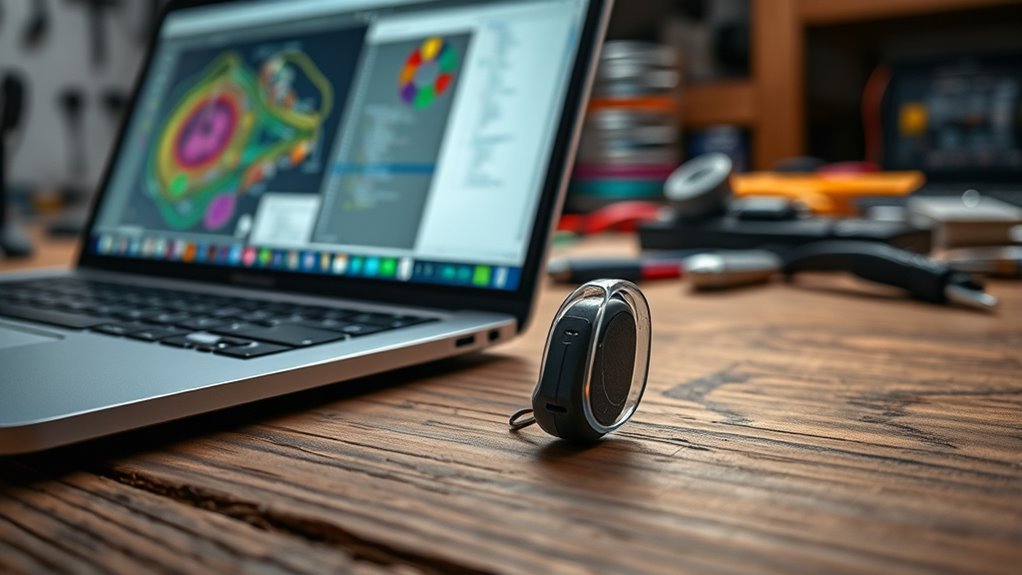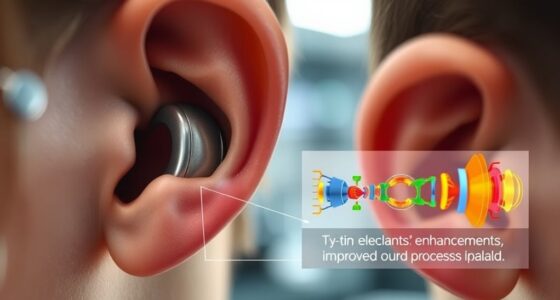You can now access affordable, personalized hearing solutions thanks to the rise of 3D-printed and open-source designs. These innovations let you customize and produce hearing aids outside traditional manufacturing, making devices more accessible and cost-effective. Advances in materials and community collaboration help improve quality and safety. If you stay with this, you’ll discover how these cutting-edge developments are transforming hearing healthcare from the ground up.
Key Takeaways
- Open-source platforms enable affordable, customizable hearing aid designs, reducing costs and increasing accessibility for DIY enthusiasts.
- 3D printing allows rapid prototyping and personalized fitting of hearing aids, fostering user-driven innovation.
- Community collaboration accelerates development, testing, and sharing of open-source hearing aid solutions.
- Integration of AI and digital health data enhances device personalization and real-time adaptation.
- Partnerships between DIY communities and industry experts promote advanced, user-centric hearing aid innovations.
The Evolution of Hearing Aid Technology

The evolution of hearing aid technology has transformed the way people experience sound and communicate. Advances in auditory neuroscience have deepened our understanding of how the brain processes sound, leading to more sophisticated devices. Today’s hearing aids are designed with better ergonomics, ensuring they fit comfortably and stay secure, which encourages consistent use. Early models focused mainly on amplifying sound, but modern devices adapt to different environments and noise levels through intelligent processing. Smaller, more discreet, and more efficient, these devices leverage insights from neuroscience to deliver clearer, more natural sound. This progress not only improves hearing but also enhances overall quality of life, making technology more accessible and user-friendly than ever before. Additionally, integration with connectivity technologies allows users to seamlessly connect their hearing aids to smartphones and other devices for a more personalized experience. Advances in open-source hardware have also fostered innovation, enabling more customizable and affordable solutions for users worldwide. Recognizing the importance of precise sound processing, manufacturers continue to refine algorithms to better mimic natural hearing and reduce auditory fatigue. Furthermore, ongoing research into advanced signal processing techniques aims to further improve the clarity and fidelity of sound in diverse listening situations. In addition, the development of Gold IRA options has introduced new investment opportunities for users seeking financial security beyond hearing technology.
The Role of Open-Source Platforms in Hearing Aid Innovation
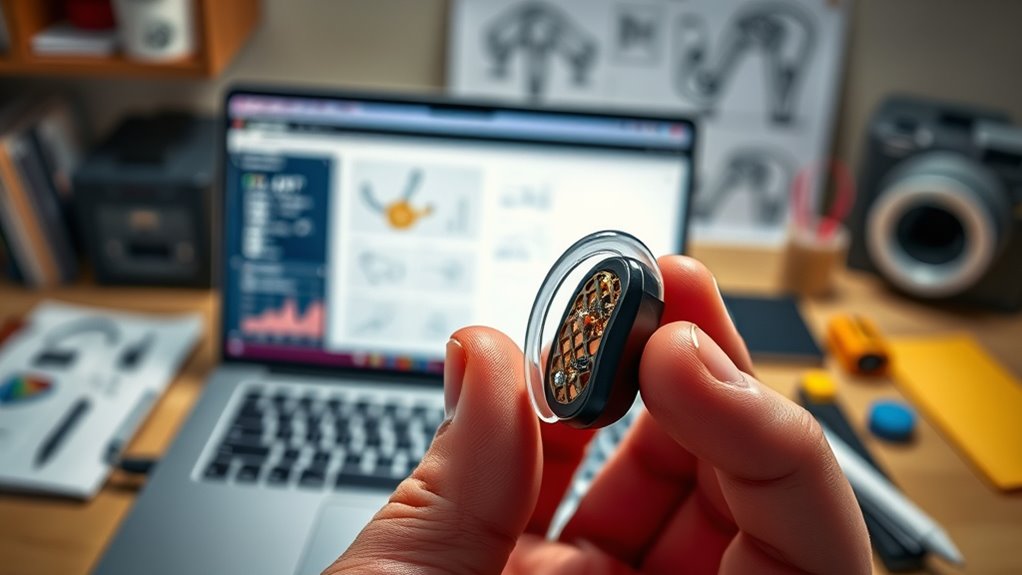
Open-source platforms foster collaborative development, allowing you to customize and improve hearing aid technology together. They also enable cost-effective innovation, making advanced solutions more affordable for everyone. By opening up these tools, you gain access to accessible hearing solutions that can be tailored to individual needs. The growing availability of affordable hearing solutions is transforming how individuals access and benefit from hearing aid technology. Furthermore, integrating educational resources can help users better understand and optimize their devices for improved outcomes. Additionally, the presence of community-driven feedback mechanisms encourages continuous improvement and rapid adaptation to user needs, ensuring that innovations remain relevant and effective. Incorporating sustainable practices in device development can also promote environmental responsibility within the industry.
Collaborative Development Ecosystems
As collaborative development ecosystems grow, open-source platforms are transforming how hearing aids are designed and improved. These platforms foster an environment of shared knowledge and resources, enabling more innovative solutions to emerge rapidly. You’ll find that manufacturing partnerships are essential, allowing for shared resources and expertise that accelerate innovation. These partnerships enable open-source communities to test, refine, and produce hearing aid components more efficiently. These collaborative efforts also promote transparency and user feedback, which is vital for creating devices that better meet diverse needs. Innovation hubs further support this environment by providing spaces where developers, audiologists, and enthusiasts collaborate, exchange ideas, and troubleshoot challenges. This collective approach breaks down traditional barriers, making hearing aid development more accessible and adaptable. You benefit from this ecosystem’s agility, as new features and improvements can be rapidly integrated and distributed. Additionally, understanding cost considerations is crucial, as open-source development can help reduce overall expenses and make hearing aids more affordable. Moreover, leveraging collaborative development ecosystems fosters greater transparency and user feedback, which are essential for tailoring devices to diverse needs. For example, incorporating modular design principles allows for easier customization and upgrades, further enhancing user satisfaction. Overall, these ecosystems foster a dynamic environment where open-source platforms drive continuous, user-centered innovation in hearing aid technology.
Cost-Effective Innovation Strategies
Collaborative development ecosystems have already begun to reshape how hearing aids are created, making innovation more inclusive and dynamic. By leveraging open-source platforms, you can reduce costs markedly, cutting out expensive proprietary processes. This cost reduction allows for more affordable hearing aid options, directly benefiting users by making hearing technology accessible to a broader audience. Open-source designs enable you to customize and improve devices without hefty licensing fees, fostering innovation from a diverse community. As a result, the overall expense of developing and producing hearing aids drops, boosting user affordability. Implementing security measures is also essential to protect sensitive data involved in open-source projects, ensuring user trust and safety. These strategies empower you to participate in creating cost-effective solutions, ensuring that advanced hearing technology is no longer confined to high-end markets but becomes a practical option for many. Moreover, employing AI-driven analysis can further optimize development processes and enhance device performance, creating smarter, more adaptable hearing aids. Additionally, the integration of digital health data can enable more personalized and effective hearing solutions tailored to individual needs. Recognizing the importance of regulatory frameworks, open-source projects can also benefit from clarity in regulatory compliance, streamlining the path to market approval and wider adoption.
Accessible Hearing Solutions
Because open-source platforms remove traditional barriers to innovation, they play a crucial role in making hearing aids more accessible. You can now develop personalized hearing solutions tailored to your specific needs without relying solely on costly commercial options. Open-source designs and community collaboration enable you to customize features, improving sound quality and comfort. This approach also markedly reduces costs, making effective hearing aids available to a broader population. By sharing ideas and improvements openly, the community accelerates innovation and drives down prices. As a result, more individuals can access affordable, personalized hearing solutions that meet their unique requirements. Open-source platforms empower you to take control of hearing aid development, fostering greater accessibility and inclusivity in hearing healthcare. Additionally, leveraging collaborative innovation can further enhance the development process by integrating diverse perspectives and expertise. Incorporating mindfulness techniques can further enhance user experience by promoting mental clarity and reducing stress during the customization process. Furthermore, understanding the importance of affordable surgical options underscores the potential for open-source solutions to complement traditional medical interventions in hearing health. Emphasizing patient-centered design ensures that innovations truly address user needs and preferences, leading to better outcomes.
How 3D Printing Transforms Customization and Production
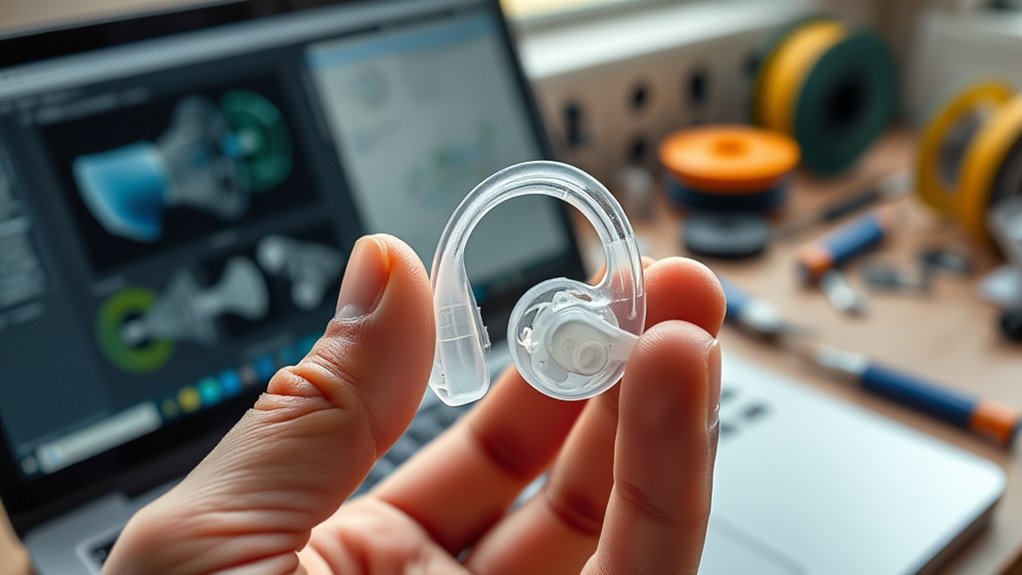
3D printing is revolutionizing how custom hearing aids are designed and produced by enabling rapid, precise, and cost-effective manufacturing. This technology offers extensive customization options, allowing you to tailor each device to fit your ear shape perfectly. Material innovations play a key role, providing lightweight, durable, and biocompatible options that enhance comfort and functionality. With 3D printing, you can quickly produce prototypes and make adjustments without costly delays, streamlining the entire process. This flexibility means you’re no longer limited by traditional manufacturing constraints, and DIY enthusiasts can create personalized hearing aids with unique features. Overall, 3D printing transforms the landscape of hearing aid production, making personalized, high-quality devices accessible to more people through innovative manufacturing techniques. This technology also promotes sustainable manufacturing by reducing waste and energy consumption.
Key Components and Materials for DIY Hearing Aids
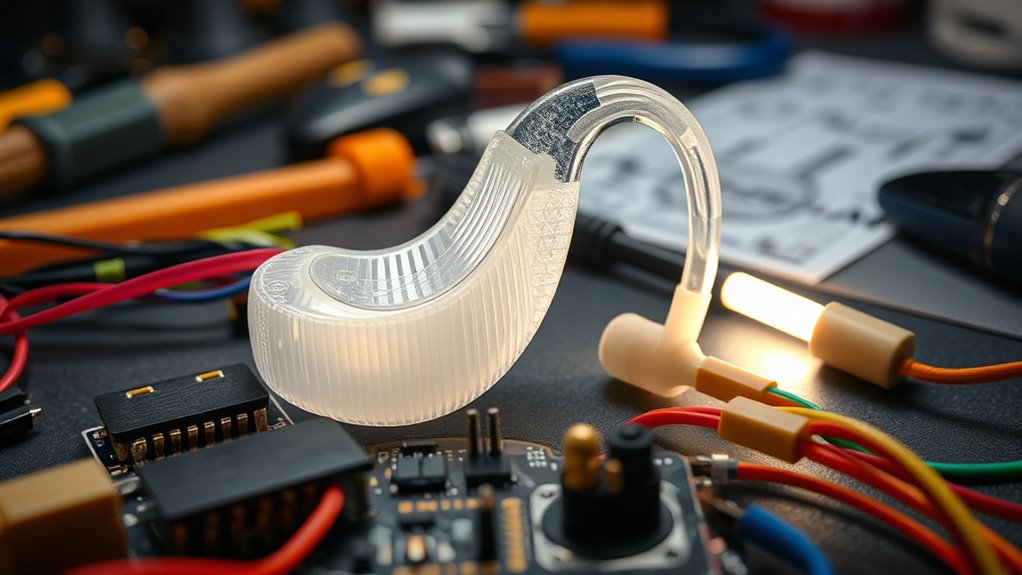
To build effective DIY hearing aids, you need to understand the essential electronic parts like microphones, amplifiers, and batteries. Choosing biocompatible and durable materials guarantees comfort and longevity for your device. Let’s explore these key components and materials to get you started.
Essential Electronic Parts
When building a DIY hearing aid, selecting the right electronic parts is essential for ensuring peak performance. Battery technology plays a crucial role, with small, rechargeable lithium-ion batteries offering longer life and reliability. You’ll also need a quality microphone to pick up sounds clearly and a speaker to deliver audio into the ear. Signal processing components, like miniaturized chips or microcontrollers, are vital for interpreting and refining sound signals. These processors help filter background noise and improve speech clarity. Choosing energy-efficient parts guarantees your device runs longer between charges. Keep in mind, the compatibility and quality of these electronic components directly impact your hearing aid’s effectiveness and user comfort. Proper selection of these parts is fundamental to creating a functional, reliable DIY solution.
Biocompatible and Durable Materials
Choosing the right biocompatible and durable materials is essential for building a comfortable and long-lasting DIY hearing aid. Biocompatible materials ensure your device won’t cause skin irritation or allergic reactions, making it safe for extended wear. Look for plastics like medical-grade silicone or acrylic, which are lightweight, flexible, and skin-friendly. Durable components, such as reinforced plastics or metal parts, provide the strength needed to withstand daily use and handling. These materials also protect internal electronics from moisture and physical damage. When selecting materials, prioritize those that balance biocompatibility with durability, ensuring your hearing aid remains comfortable, safe, and reliable over time. Proper choices in materials directly influence the performance and longevity of your DIY hearing aid.
Step-by-Step Guide to Designing and Printing Your Own Device
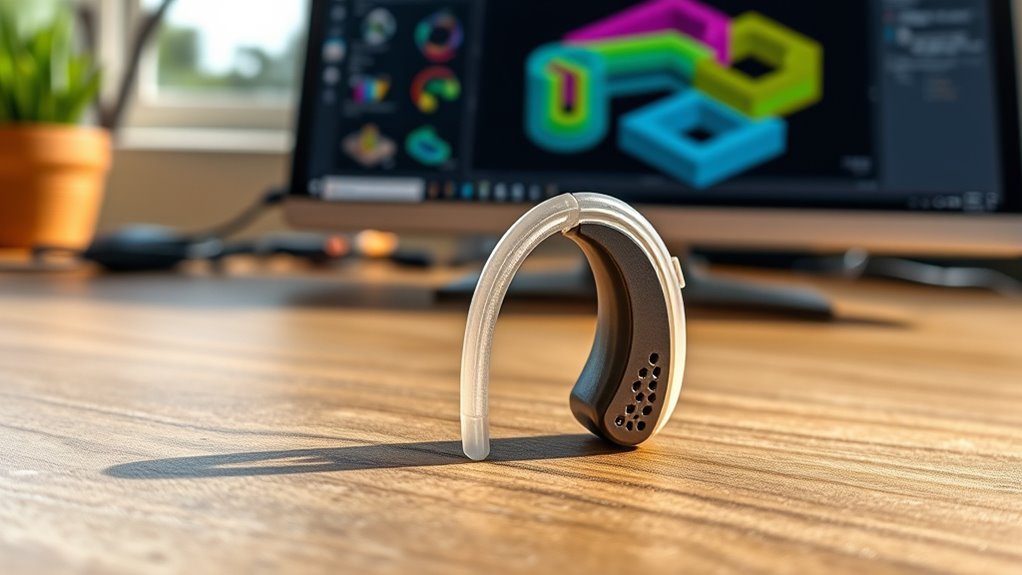
Designing and printing your own hearing aid might seem complex, but breaking it down into manageable steps makes the process straightforward. First, gather audiology research and consider how music therapy can influence your device’s design. Next, create a digital impression of your ear using accessible scanning tools or molds. Then, customize the device’s features through open-source CAD software, adjusting for comfort and sound quality. Once designed, prepare the 3D model for printing, selecting the right biocompatible materials. Finally, print the device and perform basic testing to ensure functionality. Throughout, stay informed on latest audiology research and user feedback to refine your design. This step-by-step approach empowers you to develop a personalized hearing aid that meets your needs efficiently.
Challenges and Limitations of Home-Based Hearing Aid Manufacturing
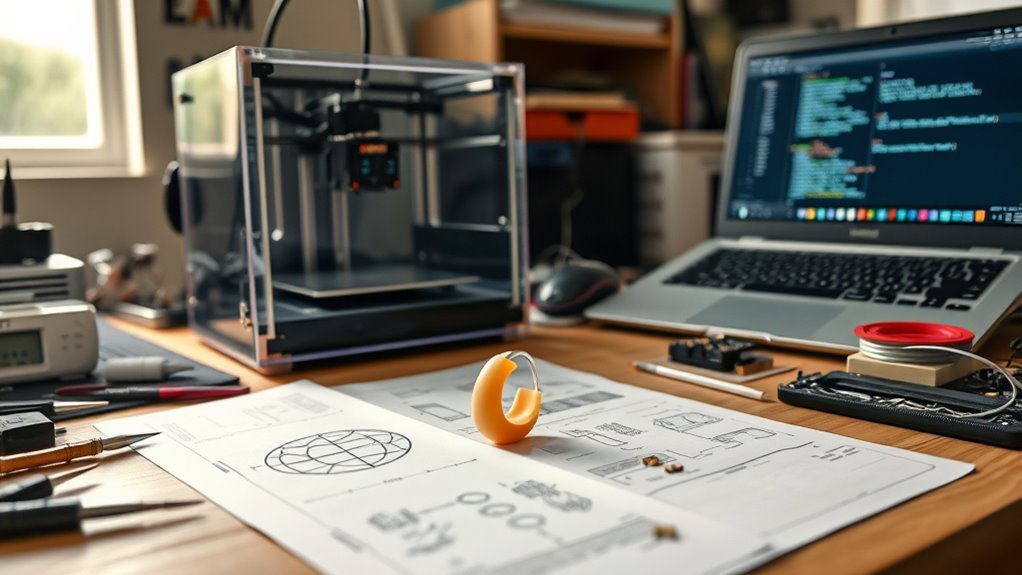
While creating your own hearing aid offers exciting possibilities, it also presents significant challenges that can limit its effectiveness and safety. One major obstacle is cost barriers; high-quality components and 3D printing materials can be expensive, making it difficult for many to access the necessary technology. Additionally, technical expertise is essential to ensure proper design, assembly, and calibration. Without proper knowledge, you risk creating a device that doesn’t fit well or fails to deliver adequate amplification, which could harm your hearing health. Quality control is another concern, as home-based manufacturing lacks the rigorous testing standards of commercial products. These limitations emphasize that DIY hearing aids, while innovative, require careful consideration of resources, skills, and safety to be truly effective and beneficial.
Community Projects and Collaborations Driving Progress
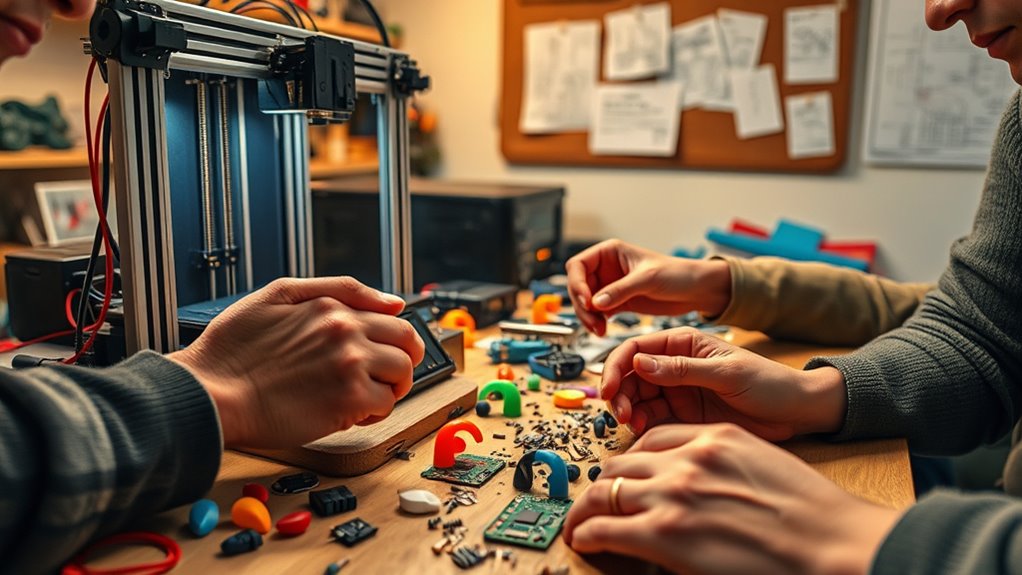
Community projects and collaborations are rapidly advancing DIY hearing aid technology by bringing together experts, enthusiasts, and organizations to share knowledge and resources. These initiatives foster peer support, helping newcomers troubleshoot and improve designs. They also open doors to funding opportunities that fuel innovation and expand access. By working together, communities develop open-source platforms, tutorials, and design files that anyone can use. You benefit from collective expertise, gaining confidence and skills through shared experiences. Partnerships with universities and nonprofits accelerate progress and ensure quality standards. These collaborations create a supportive environment, making DIY hearing aids more viable and reliable. Ultimately, they drive progress by harnessing diverse talents and resources, empowering individuals to take control of their hearing health.
Regulatory Considerations and Safety Measures
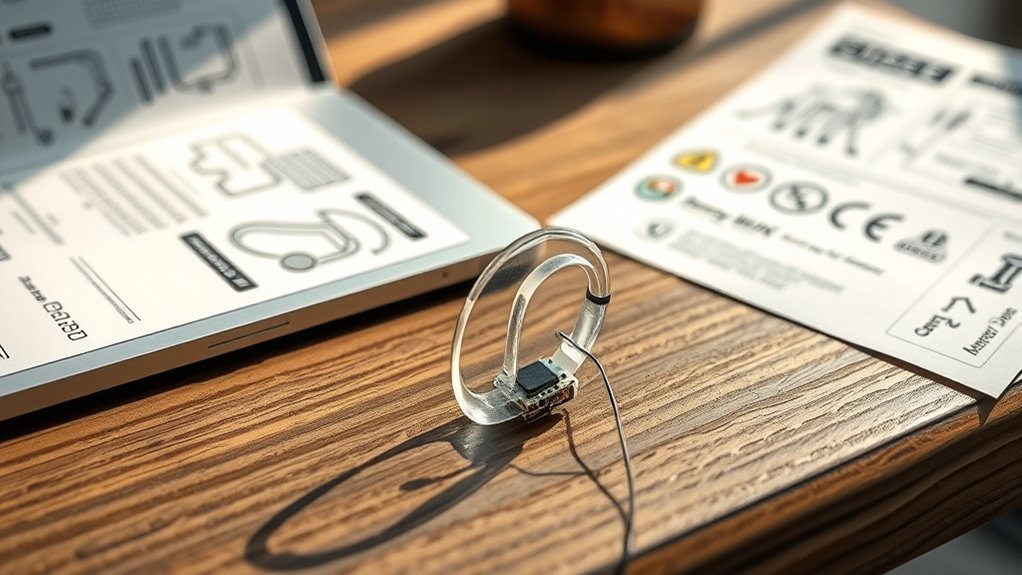
As DIY hearing aid projects grow more popular, understanding and adhering to regulatory considerations and safety measures becomes crucial to guarantee their effective and safe use. You need to be aware of privacy concerns, especially when sharing data or personal health information online. Ensuring regulatory compliance is essential to avoid legal issues and protect users’ well-being. Check local regulations regarding medical device modifications, as unauthorized devices may lack safety standards. Use high-quality components and follow precise assembly instructions to prevent malfunctions or damage. Always test your devices thoroughly before use, and encourage users to consult hearing healthcare professionals when possible. Prioritizing safety and privacy helps build trust in DIY solutions and promotes responsible innovation within the community.
Future Trends and the Impact on the Hearing Healthcare Industry

Advancements in technology and shifts toward personalized healthcare are driving significant changes in the hearing healthcare industry. As the DIY community and hobbyist innovation grow, you’ll see more affordable, customizable options emerging. This trend could democratize access, allowing individuals to tailor hearing aids to their needs. Future developments may include smarter devices with AI integration, real-time adjustments, and remote support. Expect increased collaboration between professionals and hobbyists, fostering innovation outside traditional channels. The industry might also see a rise in open-source designs, reducing costs and speeding up innovation. Overall, these trends will likely make hearing solutions more accessible, personalized, and user-centric, transforming how you experience hearing health in the years ahead.
- Increased DIY solutions and community-driven innovation
- Smarter, AI-powered hearing aids
- Greater personalization and customization options
- Expanded collaboration between hobbyists and professionals
- Reduced costs through open-source designs
Frequently Asked Questions
What Skills Are Required to Successfully Design a DIY Hearing Aid?
To successfully design a DIY hearing aid, you need a good understanding of electronic circuitry to build and connect components properly. You should also be skilled in sound calibration to guarantee clear audio quality and proper amplification. Additionally, familiarity with 3D modeling helps in creating custom casings, while patience and problem-solving skills are essential to troubleshoot issues and refine your design for ideal performance.
How Do DIY Hearing Aids Compare in Performance to Commercially Available Devices?
While DIY hearing aids might not match high-end commercial devices’ precision, they offer notable benefits. You’ll find they’re often more cost-effective and provide excellent customization options, allowing you to tailor sound settings to your needs. However, commercial devices typically boast more refined performance and reliability. You get a trade-off: affordability and personalization versus polished performance, so consider what matters most to your hearing needs.
Are There Any Legal Restrictions on Manufacturing and Using Homemade Hearing Aids?
You should know that manufacturing and using homemade hearing aids can face legal restrictions due to regulatory compliance issues. Authorities often require devices to meet safety and performance standards, raising liability concerns for DIY creators. While you might experiment at home, using or distributing these devices without proper approval could lead to legal consequences. Always consider consulting professionals or adhering to regulations to guarantee safety and avoid potential legal issues.
What Are the Long-Term Maintenance and Durability Considerations for DIY Models?
Imagine your DIY hearing aid as a garden that needs constant care. Over time, components face wear, like leaves aging and branches weakening, impacting lifespan. You might encounter repair challenges if parts break or degrade, making maintenance tricky. To keep it thriving, you’ll need to monitor component lifespan closely, perform regular checks, and be prepared for DIY fixes, ensuring your homemade device remains effective and durable over the long haul.
How Can Beginners Ensure Safety and Efficacy When Creating Their Own Hearing Aids?
To guarantee safety and efficacy when creating your own hearing aids, focus on DIY safety by thoroughly researching components and following proven guidelines. Use reliable open-source designs and consult audiology resources to match your needs. Test your device properly before regular use, and consider seeking professional advice to verify your setup. This approach helps guarantee your DIY hearing aid is both safe and effective for daily use.
Conclusion
As you venture into DIY hearing aid innovation, imagine wielding a powerful brush to paint a future where technology and community blend seamlessly. With open-source tools and 3D printing as your palette, you hold the brush to craft personalized solutions that break barriers. Embrace the journey, knowing you’re shaping a landscape where accessibility blooms and the sound of progress echoes louder than ever. Your hands are the keys to a more inclusive auditory world.

